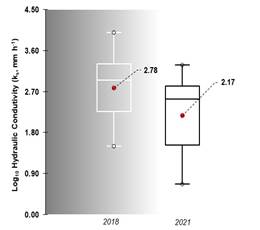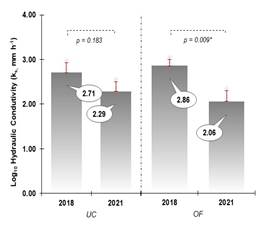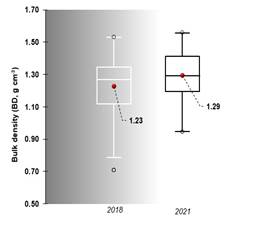INTRODUCTION
According to the European Environmental Agency, the agro-sylvo-pastoral Montado/Dehesa sytems, are classified as High Nature Value Farming Systems (Paracchini et al., 2008). Combining biodiversity and the pursue of farming on certain types of land and the conservation of regional farming systems (Berrahmouni & Regato, 2007), the Montado/Dehesa systems through agriculture and forestry are targets of public policies concerning the provision of goods supply (Pinto-Correia et al., 2011). Over the last decades the Montado/Dehesa systems have faced several perturbations, such as intensification and/or extensification, that have led to the landscape change (Pinto-Correia, 1993) and served, both ways, as a menace to their ability for goods supply. Covering nearly 4 million ha of the southwestern Iberian Peninsula and being a system of high importance in the southern European region, due to its economic, social and environmental value; the conservation and management optimization are of great concern in an era of climate change and need of maximum optimization of goods production (Pinto-Correia et al., 2011).
Measures for soil conservation and protection, aiming to fight the effects of climate change, such no/reduced-tillage and bio-diversification/improvement of pasture plants were applied in 12 pilot areas distributed between Alentejo (Portugal), Extremadura and Andalusia (Spain), and monitorized between 2018 and 2021 (EU-Life, 2016). The LIFE Montado-Adapt project aimed to “promote the adaptation of the Montado/Dehesa system in Portugal and Spain…to mitigate the consequences of climate change…” (LIFE Montado-Adapt, 2022), by evaluating the effects of such soil conservation practices regarding the soil carbon sequestration, promoting water infiltration and soil water retention.
This work presents an assessment of the changes of soil saturated hydraulic conductivity (ks) and bulk density (BD), prior and after the soil conservation practices took place, between 2018 and 2021, in 4 of the project pilot areas.
MATERIALS AND METHODS
Study sites
Pilot areas used in this work were (Life Montado-Adapt 2022): Dehesa of Guijo, Malpartida de Plasencia, Cáceres, Spain (n=6, L3); Dehesa of Boyal de la Piedra, Villasbuenas de Gata, Cáceres, Spain (n=6, L4); National Forest of Cabeção, Mora, Portugal (n=8, L8); Ribeira Abaixo, Santa Margarida da Serra, Grândola, Portugal (n=6, L12).
In the four showcased pilot areas, measures such reduced or no tillage, diversified plantation and improved pastures took place, as described by the LIFE Montado-Adapt (2022). In Table 1 are presented some general characterization of the presented pilot areas.
Table 1 General conditions and characteristics of the presented pilot areas (LIFE Montado-Adapt, 2022)
| pilot area | L3 | L4 | L8 | L12 |
|---|---|---|---|---|
| plot (ha) | 6.15 | 3.8 | 3.2 | 4.08 |
| cattle | + | + | - | - |
| Soil textural classe | Loam | Sandy-loam Loamy-sand | Sandy | Loam Silty-loam |
| Tree species | Quercus rotundifolia L. | Quercus suber L. |
Soil sampling and analysis
Random sampling occurred in two moments the first between January-March of 2018 and the second between June and July of 2021. The soil sampling involved two strata: under the canopy of trees (UC) and open field (OF), outside the canopy influence. Each pilot area had six to eight sampling sites. In each site, two collection points were carried out along the N-S axes, about 1 m from the trunk under the tree canopy and about 2 m apart from each other in the open field areas, with cylinders, of 100 cm3.
The cylinder samples were used to determine the soil bulk density, BD, (g cm-3) and the saturated hydraulic conductivity (CaCl2 0.005M), ks (mm h-1), in a laboratory permeameter using the Eijkelkamp® apparatus, with the constant head method.
Soil ks values were log10 transformed to overcome environmental variability and obey normality assumptions. Statistical analysis for data description, means T-test (α=0.05) were performed using the XLSAT Microsoft® software.
RESULTS AND DISCUSSION
Soil Hydraulic conductivity, k s
The observed ks decreased on average 22%, since the first sampling in 2018, Figure 1, with statistical significance (α=0.05, p=0.005, n=26). With the L3 and L4 areas showing the highest soil ks reduction, 37% and 30% since 2018 (2.25 and 2.35 mm h-1), respectively. It must be noted that these areas are subjected to high livestock grazing pressure, which has been shown to be a cause of soil compaction and soil permeability reduction (Chandler et al., 2018).

Figure 1 BoxPlot’s representation of the soil hydraulic conductivity, ks (Log10, mm h-1), of the 2018 and the 2021 sampling, the means are in bold.
Nevertheless, L8 and L12 areas also presented a decrease, 16 and 13% (2.84 and 3.46 mm h-1), respectively, since 2018. In these cases, the reduced or even no tillage management may have a significant role, especially in L8, where the soil samples are of sand texture. Although seasonal effects on ks (and also on bulk density) are not fully understood, they may have played a role in results obtained (Hu et al., 2012). However, it can be relevant that higher reduction in ks was observed in the L3 and L4 areas, which are grazing areas.
When assessing the changes in ks values under and out of tree canopy influence, although there was a trend for a decrease in all pilot areas, the differences were only statistically significative in the OF areas, Figure 2, where a decrease of nearly 28% was observed. This stresses that soils in OF areas are more prone to stand negative impacts related to cattle, people and machinery traffic, namely due to potentially more traffic intensity in these areas, among other factors.

Figure 2 Bars and standard errors of the effects of the soil conservation practices system implantation on soil hydraulic conductivity, ks, under (UC, n=13) and outside (OF, n=13) of tree canopy influence (*α=0.05, significance level).
Soil Bulk Density, BD
The soil bulk density increased on average 5% since 2018 (1.23 g cm-3), Figure 3, but no statistical significance was observed. Wherein L3 area showed the higher increase, 12%, since 2018 (1.16 g cm-3) while L4 and L8 only increased 4 and 5% (1.37 and 1.20 g cm-3), respectively. However, L12 area decreased 4% in relation to the observed 2018 BD (1.20 g cm-3), with no statistical significance. It must be noted that the L8 had an outlier, prompted by the presence of a stone in the collecting cylinder. Without this outlier, the L8 area BD also decreases, nearly 3% (n=5).

Figure 3 BoxPlot’s representation of the soil Bulk density, BD (g cm-3), of the 2018 and the 2021 sampling, the means are in bold.
The average soil BD increase in the L3 and L4 areas may be the effect of the livestock high density in these pilot areas (Chandler, et al, 2018), which is not observed in the L12 and L8 (without the outlier). There were no observed statistical significative changes in the samples collected in the UC or OF sites, with the soil conservation practices.
CONCLUSION
The soil conservation practices may already be stressing its effects on soil physical properties, such ks and BD, especially in the areas where no livestock pressure exists. The decrease in soil permeability may be an effect of the reduced/no tillage practices, leading to a more stable and aggregated soil superficial horizon, which also promotes a lower BD, due to trees and plant roots development, especially in areas without cattle, people, machinery traffic.














